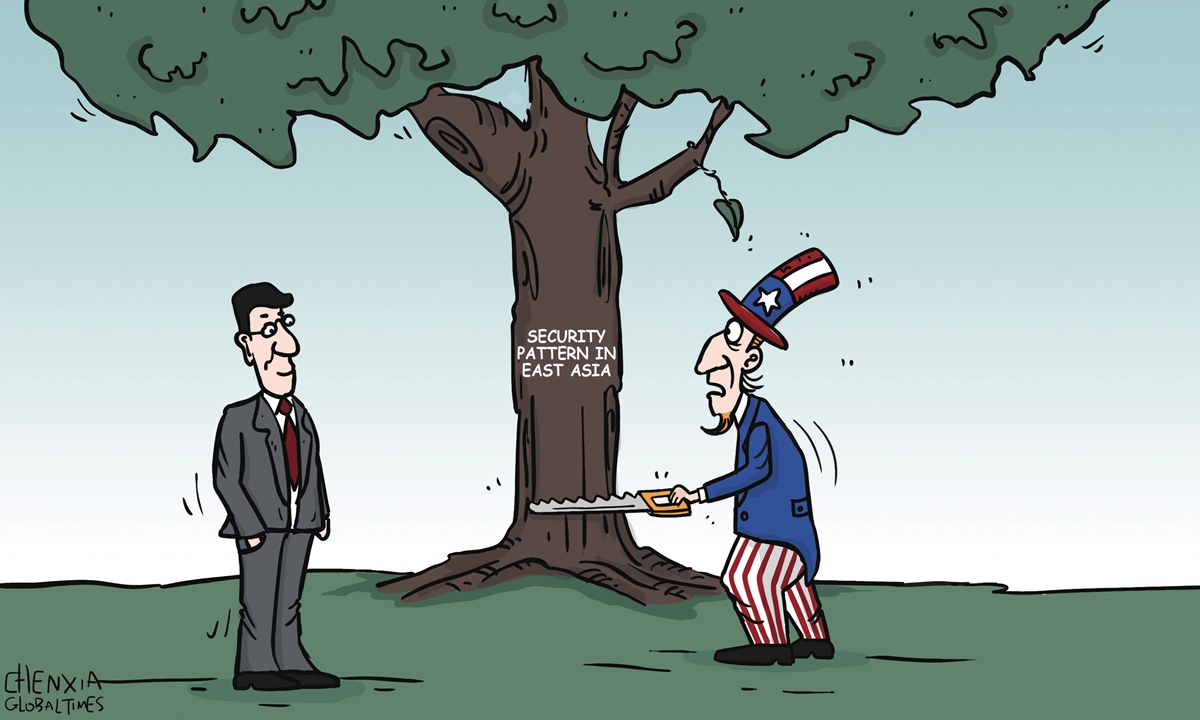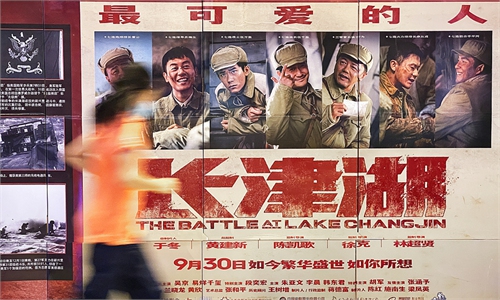
Illustration: Chen Xia/GT
The blockbuster film The Battle at Lake Changjin was aired on-screen during China's National Day holidays with astonishing box-office numbers. It once again promoted the Chinese public's profound interest in the Korean War (1950-53). Online discussions about the war are particularly hot, reminding many people of current China-US relations.
The battle at Lake Changjin on the Korean Peninsula, taking place in November 1950, was a major turning point of the Korean War. It laid the foundation for the development of the security pattern in East Asia.
It was an offensive led by Chinese troops under extremely cold conditions against US forces who were marching northward toward the North Korea-China border. During the 17-day cruel war, the poorly equipped Chinese soldiers, with unprecedented and indomitable spirits, dealt a heavy blow to the US army, which had been overbearing since the end of the World War II.
Although the Chinese side suffered huge losses during the war, one thing was certain: Following the conflict, the Americans' perception of the Korean War, of the People's Republic of China and of the Chinese army went through a major and significant change.
It was this very change that helped shape the ensuing security pattern of East Asia, which has not fundamentally altered even until today.
Back in the 1950s, China was a poor and underdeveloped country whose defense strength was pretty weak compared with that of the US and that of the former Soviet Union. Yet after the Korean War, China became a pillar in the political and security architect of the Asia-Pacific region.
When external powers, especially the US and the Soviet Union - the two major powers at that time - deployed their strategies in Asia, they had to take China into consideration. China became an important force independent from the two major military pacts - NATO and the Warsaw Pact.
The ambitions China displays as a powerful country can be traced back to its history and cultural traditions, as well as its sufferings since the onset of the modern times. Therefore, China did not become a vassal state of the US or the Soviet Union. Nor today will it develop itself by copying the models of either of the two. Because of this, China and the Soviet Union split. And the administration of former US president Richard Nixon tried to take advantage of China as a strategic leverage against the Soviet Union, although China and the US were in a state of confrontation after the Korean War.
In 1979, China and the US officially established diplomatic relations. Almost at the same time, China kick-started its reform and opening-up, which provided impetus for the development of stronger China-US ties. This has also gradually made China the most proactive factor amid the changes in political, economic and national defense spheres in the Asia-Pacific region. China had not been regarded by the US as its biggest challenge to the latter's hegemony in the region until the past few years.
However, the regional security structure that influences China-US ties after the Korean War, as well as the contradiction and conflicts brought about by this structure, have not been completely resolved.
For China, this is mainly caused by three factors: China's national reunification has not yet been achieved; The confrontation on the Korean Peninsula still exists and the Korean Peninsula nuclear issue has not been resolved; The military alliance system established by the US in this region after the Korean War, especially after the end of the Cold War, is being activated again. The US is trying to turn its target against China.
China's grand goal of national rejuvenation is directly related to the above-mentioned three issues. The most important thing for China remains how to best achieve its goals and ensure its influence over surrounding areas.
This is also a challenge the US has to face.
In April, the Council on Foreign Relations, a New York-based think tank, published a paper by Evan S. Medeiros, former US president Barack Obama's top advisor on the Asia-Pacific region. In this report, entitled, "Major Power Rivalry in East Asia," Medeiros claimed that preventing the rise of a regional hegemon is a specific manifestation of the broader US objective in Asia.
As China rises, Washington has started to regard Beijing as its "challenger." It moved to comprehensively contain Beijing. And the structural conflict in the security pattern of East Asia has become increasingly obvious since the Korean War. As a result, the entire region is now in a dilemma of whether to take sides. This has raised more fears about the possibility of an outbreak of a war between China and the US.
The challenge faced by both Beijing and Washington in the 21st century is how to build a new security architecture in East Asia instead of continuing the existing one. And this new framework has to be in the interests of all regional countries.
China and the US must cooperate. After all, only through cooperation can the two coexist and push the transformation of the security architecture in the region.
But the basis of the cooperation is: The US must accept China's ambition to rejuvenate the Chinese nation.
The author is a senior editor with People's Daily, and currently a senior fellow with the Chongyang Institute for Financial Studies at Renmin University of China. dinggang@globaltimes.com.cn. Follow him on Twitter @dinggangchina


